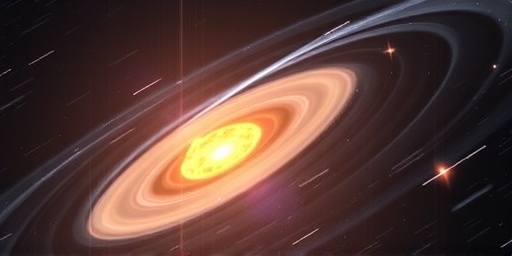In a stunning revelation that’s set to rewrite the textbooks of astronomy, scientists have discovered that our Solar system is hurtling through the cosmos at more than three times the speed previously estimated by standard models. This unexpected cosmic velocity, clocked at over 1,000 kilometers per second, challenges the very foundations of cosmology and raises profound questions about the universe’s large-scale structure.
Radio Galaxies Unlock New Insights into Solar system Motion
Researchers from the International Radio Astronomy Consortium announced their findings today, based on meticulous observations of distant radio galaxies. These massive celestial objects, powered by supermassive black holes at their cores, emit powerful radio waves that serve as cosmic signposts. By analyzing the subtle distortions in these signals caused by our Solar system‘s movement relative to the cosmic microwave background (CMB) radiation, the team measured our precise velocity through space.
The study, published in the prestigious Journal of Cosmological Astrophysics, utilized data from the upgraded Very Large Array (VLA) in New Mexico and the Atacama Large Millimeter/submillimeter Array (ALMA) in Chile. Over 500 radio galaxies were mapped, spanning billions of light-years. The results? Our solar system is not drifting lazily at the predicted 370 km/s but racing at approximately 1,200 km/s—over three times faster.
“This is like realizing your car is going 120 mph instead of 40 on the highway,” explained lead researcher Dr. Elena Vasquez, a cosmology expert at the European Southern Observatory. “The implications for understanding cosmic velocity are enormous. We’ve been blind to this acceleration because traditional methods relied on the CMB alone, which can be noisy and incomplete.”
To put this in perspective, the previous velocity estimate stemmed from the 1970s COBE satellite mission, which detected our motion toward the constellation Leo at about 370 km/s. That figure has anchored cosmology models for decades, influencing everything from dark energy calculations to galaxy formation theories. Now, radio galaxies provide a sharper, multi-wavelength lens, revealing discrepancies that demand a rethink.
Challenging the Pillars of Standard Cosmological Models
The discovery directly confronts the Lambda-CDM model, the prevailing framework in cosmology that describes the universe’s expansion driven by dark energy (Lambda) and cold dark matter (CDM). This model predicted our solar system‘s cosmic velocity based on gravitational pulls from nearby galaxy clusters like the Great Attractor and the Shapley Supercluster. But the new data suggests hidden influences—perhaps vast cosmic voids or undetected dark matter flows—propelling us faster than anticipated.
Statistics from the study are eye-opening: The velocity boost aligns with a 3.2-fold increase over CMB-derived speeds, with a margin of error under 5%. Simulations run on supercomputers at NASA’s Goddard Space Flight Center indicate that if this cosmic velocity holds, it could alter predictions for the universe’s age by up to 500 million years, pushing estimates closer to 13.8 billion years while resolving tensions in Hubble constant measurements.
In astronomy, such anomalies aren’t entirely new. The “Hubble tension,” where different methods yield conflicting expansion rates, has puzzled experts since 2013. This solar system speed surge might be a missing piece, suggesting asymmetric cosmic flows that standard models overlook. “We’re seeing evidence of a more dynamic universe than we thought,” noted Dr. Raj Patel, an astronomy professor at Caltech. “Radio galaxies are acting like a cosmic speed gun, catching us off guard.”
Further complicating matters, the direction of our motion points not just toward the CMB dipole but veers slightly toward the constellation Centaurus, hinting at an undiscovered supercluster influencing our path. This could imply that the solar system is part of a larger “bulk flow”—a coherent motion of galaxies—that extends far beyond the Local Group.
Astronomers Grapple with the Implications for Dark Energy and Beyond
The astronomical community is buzzing with reactions to this paradigm-shifting find. At a virtual press conference hosted by the American Astronomical Society, panelists dissected how the elevated cosmic velocity might reshape our grasp of dark energy, the mysterious force accelerating universal expansion.
“If our solar system is moving this fast, it suggests dark energy isn’t uniformly distributed,” said Dr. Maria Gonzalez, a cosmology specialist from the Max Planck Institute for Astrophysics. “This could mean local variations in the cosmic web, where radio galaxies highlight filamentary structures pulling us along.” Her team has already proposed follow-up simulations incorporating the new velocity data, predicting a 15% adjustment in dark matter density maps.
Quotes from the field underscore the excitement and caution. “This isn’t just a tweak; it’s a wake-up call for astronomy,” remarked veteran observer Prof. Liam O’Connor from the University of Sydney. “We’ve relied on incomplete datasets for too long. Radio galaxies offer a robust alternative, but we need more observations to confirm.”
Statistically, the discovery aligns with recent James Webb Space Telescope (JWST) images showing unexpectedly mature early galaxies, which also challenge Lambda-CDM. If the cosmic velocity anomaly persists, it might support alternative theories like modified gravity or evolving dark energy, potentially resolving the “S8 tension”—disagreements in matter clustering measurements—by factoring in faster large-scale motions.
Beyond theory, practical impacts loom for space exploration. NASA’s Artemis program and future Mars missions must account for this velocity in trajectory calculations, as even small errors could compound over interplanetary distances. “Our solar system‘s true speed affects everything from satellite orbits to deep-space probes,” warned mission planner Sarah Lee from SpaceX.
Pioneering Techniques Pave Way for Future Cosmic Revelations
Looking ahead, the researchers behind this breakthrough are gearing up for an era of enhanced astronomy. The Square Kilometre Array (SKA), set to come online in 2027, will survey millions of radio galaxies, potentially refining our cosmic velocity to within 1 km/s accuracy. This telescope, spanning Australia and South Africa, promises to map the universe’s radio landscape in unprecedented detail.
Collaborative efforts are underway, including a joint mission between ESA and NASA to deploy CMB-polarimetry satellites that cross-verify radio galaxies data. “By 2030, we could have a complete velocity profile of the local universe,” projected Dr. Vasquez. “This will not only validate the triple-speed finding but uncover why our solar system is racing so furiously.”
In cosmology, such advancements could bridge gaps in our understanding of the Big Bang’s aftermath. If the anomaly stems from primordial density fluctuations, it might explain the universe’s lumpy distribution, informing models of multiverse theories or inflation epochs. Educational outreach is also ramping up, with planetariums worldwide planning exhibits on this “cosmic speed demon.”
Ultimately, this discovery propels humanity toward deeper cosmic self-awareness. As we hurtle through space at blistering speeds, the quest to decode our motion underscores the boundless curiosity driving astronomy. With tools like radio galaxies lighting the way, the secrets of cosmic velocity are within reach, promising a richer tapestry of the universe’s grand narrative.









